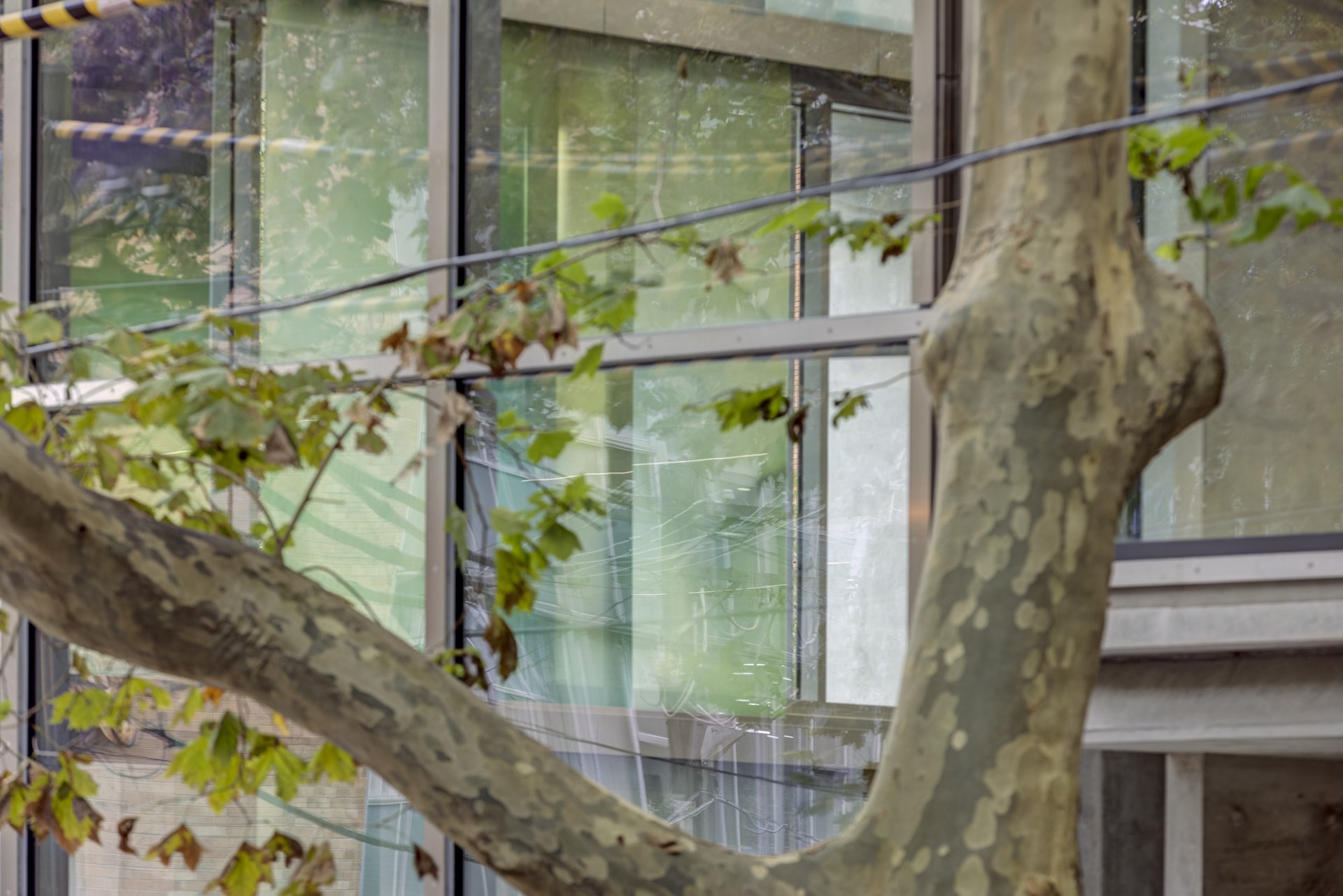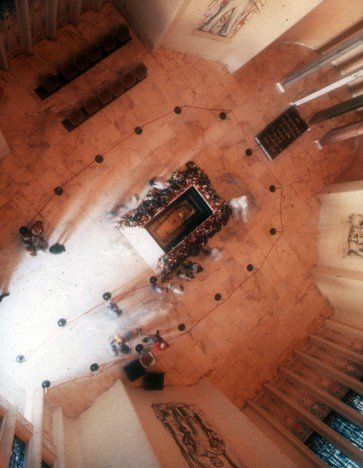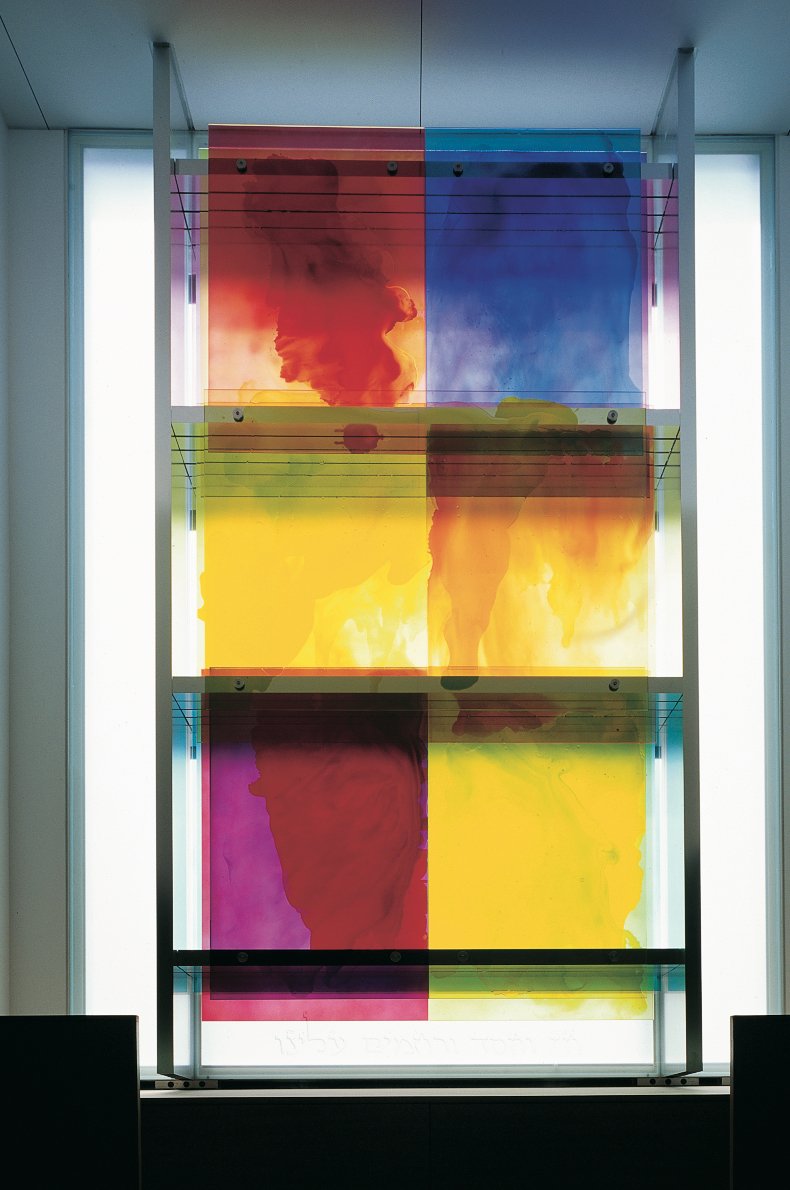
Architectural





The Breath in Glass
72-84 Foveaux Street, Surry Hills, Sydney, 2022
Ephemerality, ambiguity, veiling, membranous, flows, disbursing, blurring, elemental and in a constant state of transformation.
Atmospheric formations link the grounded world and the air moving above the earth’s surface. The work bleeds between the inside and the outside, bringing the changing tree foliage into ephemeral glass veils. The Breath in Glass creates a cloud like atmosphere, bringing in the color of the trees outside and introducing those ephemeral colors into the glass. The work creates elemental and fugitive spaces that express the ephemeral through a language of veiling, transparency and translucency to form enmeshed environments. These slowed spaces express porosity and fluidity and a fusion with the environment. There are no boundaries but membranes. The Breath in Glass creates a way of seeing. The veiling and layering of colour creates a sense or a memory of something diffused appearing and disappearing like clouds.
Colour inserted laminated glass
In collaboration with Candelapas Associates Architects and Stasia Property Limited


Pollination
Poly Building, 210 George Street, Sydney, 2022
Duraclear images on curved acrylic
In collaboration with UAP

In stance of memory
(Garden of the Jewish Museum, Berlin), Art Gallery of New South Wales collection, Sydney, 2005
Duraclear on shinkolite, oxides and ash in oil, rusted steel
Photograph by Diana Panucci
The Memory of Lived SPaces
Changi Airport, Terminal 3, Singapore, 2007
Blending architecture and nature, the work overlaps photographic panels with painted glass to create ambiguous spaces that compel you to revise your sense of location, context and fixity. Transparent images bounce off reflections and mirrored surfaces within and outside the structure to cast a melange of colours and shadows on the white wall behind.


Water veil
CH2 Artworks, Commissioned by the City of Melbourne, Melbourne, 2006
'Water Veil' is a diaphanous, experiential, reflective glass veil that transforms the window between the foyer and the street space at CH2, the City of Melbourne building. It creates a membranous, fluid space in the urban context. It reveals the transformation and purification of water. the wall is made up of layered 'veils' of crystal-clear star-fired glass panels. Each panel represents the chemical elements removed or transformed during water's purification and filtration. The symbols for these elements and their measurements are screen-printed in transparent silver – light or lead coloured. The paint pours vary from granular grey-black to silver and clear, expressing the water's progression from particle state to transparent. The artwork has an educative and interpretive function within the building, and it creates a dramatic effect from the external public space. It serves to amplify the functionalism of CH2 building as an environmentally sustainable building.
Glass, steel brackets, minerals, pigments, oil glaze

The Green Between
Crown Promenade, Melbourne, 2005
In association with Sherman Galleries and BatesSmart Architecture
painted layered glass panels



The Edge of the Trees
Museum of Sydney, 1995
Both an exhibit of the museum and a public sculpture, on the site of first Government House
there is the memory of the site
the botanical memory
the Eora memory
the colonial memory
through a language of
materials
naming
mapping
Sandstone, wood, steel, oxides, shells, honey, bones, zinc, glass, sound, 29 pillars
created in collaboration with Fiona Foley, curated by Peter Emmett


Tomb of the Unknown Soldier (The Four Elements)
Tomb of the Unknown Soldier, Hall of Memory, Australian War Memorial, Canberra, 1993
A concept that expresses the four elements with four materials; glass, stone, metal, and wood.
Wood, marble, steel, glass
In collaboration with Tonkin Zulaikha Greer Architects, photographs by John Gollings
Australian War Memorial
Hyde Park Corner, London, 2003
A gathering space to commemorate the two World Wars, where Australia sent thousands of young men, whose places of birth are inscripted into the stone in the small text. In the large text names the places where many died, the places of the huge battles. The work is a lament for the loss of lives through war. The texts weave in and out of one another beneath falling water.
Engraved granite, bronze
In collaboration with Tonkin Zulaikha Greer Architects, photographs by Patrick Bingham Hall
A Garden for Edna Walling
Private collection, Melbourne, Australia, 2000
Glass, aluminium, shinkolite, acrylic, Duraclear, oil, glaze pigments
Photographs by John Gollings




49 Veils
Central Synagogue, Sydney, 1998
The windows of the Central Synagogue describe the mystery of the penetration of the infinite Eternal One metaphorically, through the process of ten emanations (seriphot). These seriphot can be grouped into four categories, represented by the four windows: unity, knowledge, love, and manifestation. The medium for communication between G-d and man and vice-versa is represented in the windows by numerous veils of coloured glass. There are 49 veils in the work: 49 is a significant number in the Jewish tradition. As there were seven days of creation, the number seven represents perfection. Seven multiplied by seven is regarded as the ultimate perfection, as expressed by the number of days between the Pesach Festival and the Festival of Shavuot. Thus the number 49 is symbolic on the highest level of spirituality that is possible in the context of this world.
(text by Rabbi Selwyn Franklin)
49 painted glass panels, polished aluminum
In collaboration with Jisuk Han, photographs by John Gollings


